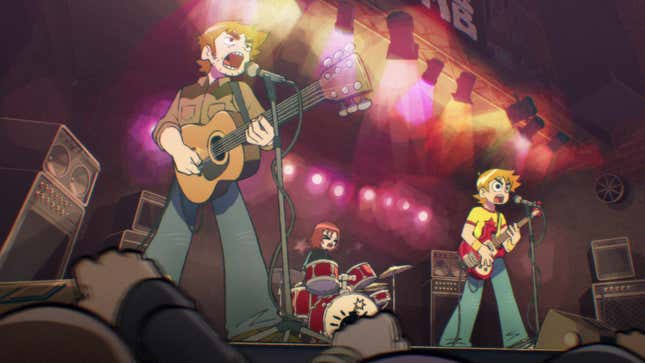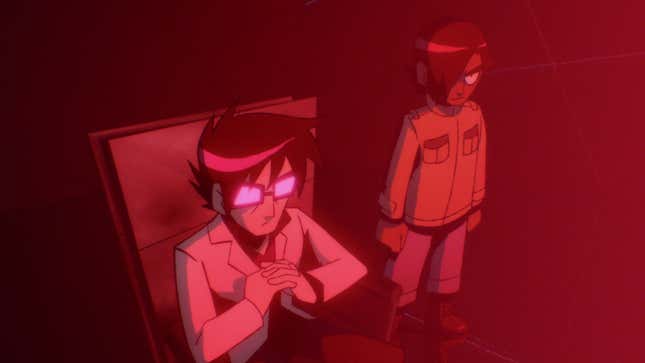Let’s get it out of the way: This is not a spoiler-free review of Scott Pilgrim Takes Off. Netflix’s anime take on Bryan Lee O’Malley’s video game reference-ridden romantic comedy graphic novels and their subsequent live-action movie adaptation is impossible to talk about while tiptoeing around specifics. I’m not going to tell you how it all ends, but I do have to set the stage in a way that will give away a great moment in the first episode if I’m going to talk about this show with any sort of conviction.
If you’re just looking for a quick thumbs up or thumbs down, then yes, you should watch Scott Pilgrim Takes Off if you are a fan of the original story and have also seen the film. Hell, throw the very good video game in there, too. The anime is in conversation with the source material, and despite still being about the titular dopey, irresponsible fuck-up and his enigmatic delivery girl love interest Ramona Flowers, it’s still best experienced when you know what this series is all about. And here’s why:

Scott Pilgrim Takes Off starts off similarly enough. Most of the first episode is a faithful retelling of Scott meeting Ramona, becoming infatuated with her, and then ordering a movie for her to deliver to his home so he can ask her out. Their date is sweet, their respective pasts are shrouded in mystery, and as things start to pick up between them, their budding romance is interrupted by Ramona’s ex Matthew Patel attacking Scott at a battle of the bands show. Anyone who’s seen the movie or read the books knows that Scott is supposed to win this fight. But this time, Matthew comes out victorious, seemingly killing Scott, and it becomes clear we’re on a completely different ride.
Scott Pilgrim Takes Off is not a retelling of Scott Pilgrim or its movie adaptation. It’s a third, alternate version of the story that examines the very premise all of this was built on. Think The Rebuild of Evangelion or Final Fantasy VII Remake. While the source material focuses on Scott facing Ramona’s Seven Evil Exes in a desire to win the “right” to date her (wow, that sounds incredibly loaded all these years later just typing it out), the anime’s title is pretty apt because, for several episodes, Scott Pilgrim is barely even in the show.

That’s because it’s not really about him this time around. Scott Pilgrim Takes Off is Ramona’s story, and after the live-action movie did her so goddamn dirty (A mind control chip? Really?) I was actually pleasantly surprised with this framing and exploration of the Scott Pilgrim story. Part of me is a little disappointed that we got all these incredible actors back from the film to voice these characters and didn’t get a chance to do better at re-telling that story, this time avoiding things like relegating Nega Scott to a bit, completely stripping Ramona’s story of nuance with the aforementioned mind control chip, and cutting out characters and relationships for time’s sake. But the second I realized what Scott Pilgrim Takes Off was actually about, I knew this was the right call and was glad to be on the ride.
Even if it’s not a direct retelling, Scott Pilgrim Takes Off still manages to pull some story beats off with more sincerity than the live-action film did. I bought into Scott and Ramona’s relationship more here thanks to better writing, pacing, and performances from both Michael Cera and Mary Elizabeth Winstead. Because I was enjoying that relationship much more this time around, I did have a brief moment of disappointment when it became clear this show wasn’t going to be telling the story I already knew, but that was quickly replaced by a heartwarming delight as I was drawn into the anime’s own intricacies and its willingness to examine the series’ blindspots.
The entire premise of Scott Pilgrim is that Ramona’s exes have formed a group of superpowered villains who are out to ruin her love life for the rest of eternity. As soon as a new paramour throws their hat into the ring, the exes swoop in to curb-stomp them so that Ramona will get back together with whoever wins the fight. That’s the idea, at least. It doesn’t seem like any of them actually stopped to think about whether or not Ramona would willingly go with any of them. But these exes are villains of the week who Scott and Ramona fight together and then move on from very quickly.

Even when Ramona talks about them, it’s often in a dismissive tone. Scott Pilgrim’s core conflict originates from ex-lovers who demonize each other while absolving themselves along the way. Ultimately, what makes Scott Pilgrim so great isn’t the stylized action, the witty quips, the nerdy references, but its insight into its surprisingly complex characters. And Scott Pilgrim Takes Off’s shifted perspective lets it examine characters who have often been left behind: the evil exes.
Ramona spends most of the eight-episode series begrudgingly reconnecting with her exes while investigating Scott’s mysterious disappearance at the beginning of the show. Sure, it’s got all the zany action sequences and over-the-top exaggeration long-time fans know and love, but at its core is something introspective and illuminating, lending new depth to characters who previously existed largely just to gesture at Ramona’s underlying issues. For example, take Roxy Richter, the sole woman in the League of Evil Exes, who is often dismissed by Ramona as a phase. Scott Pilgrim Takes Off starts off with the two confronting each other, and after the swords and giant hammers have stopped swinging, Ramona starts to reflect on how she is just as much an Evil Ex in Roxy’s story.
By focusing on Ramona and putting Scott on the back burner, Scott Pilgrim Takes Off critically re-examines the foundation it was built on nearly 20 years ago with the first book. Love is hard, and it’s only natural that even if we cared for someone at one point, we might start to resent them when things end. There are exceptions, of course, but more often than not the people who hurt us and the people we hurt in kind aren’t malicious; they’re flawed people just like us trying to figure it all out.
While the anime is all about unpacking the narrative baggage Scott Pilgrim has carried all these years, the characters remain as emotionally and psychologically complex as ever. Their thorny interpersonal dynamics are still core to the story—they just manifest in new, really effective and subversive ways.Subversion is the basis of Scott Pilgrim Takes Off, after all. Even as Ramona is making things right with the people she’s wronged and who have wronged her, that same demonizing of one’s old flames is still foundational to the story, and the show’s late-season twists are some of the best realizations of everything it seeks to explore. I won’t spoil them here, but suffice it to say that this show also takes time to make up for the film’s shortcomings instead of repeating them.

I’ve spent a lot of time talking about Scott Pilgrim Takes Off’s subversive elements because that’s where it excels, but the show also still presents a delectable recreation of the series’ best elements in this new framing. It’s gorgeously animated and colorful, with some excellent choreography to its over-the-top fights. The writing is just as sharp, witty, and full of pop culture references, but doesn’t feel so beholden to that tone that it’s just constantly winking at the camera. The show brings the kind of laugh-out-loud absurdist humor that made the original’s gags so memorable but doesn’t feel like it’s just playing the hits. That refreshing newness is well married with its comfortable familiarity and comes from its knowing subversion of what we’ve come to expect, and thankfully the new material gives the voice cast a lot to work with. Characters who barely interact in the books or movie get whole arcs together, and it’s all so fresh it retroactively makes the thought of a faithful adaptation less exciting.
But with all that newness comes trepidation. At first blush, I’m not thrilled that Scott Pilgrim Takes Off ends on a cliffhanger. Getting invested in anything Netflix does is just setting yourself up for pain because the streaming service cancels shows like I delete tweets that don’t pop off. An animated Scott Pilgrim series that brought back the entire movie cast seemed too good to be true when it was announced, and now that it seems Netflix is entertaining a second season, any unabashed glee I have toward this show feels like it’s on shakier ground.
Netflix has been cutting jobs in its animation department while also relying on AI to do animation work due to what it calls a labor shortage. Scott Pilgrim Takes Off succeeds because the people at the heart of it love and understand it, and people loving something is what puts it on the chopping block at Netflix, it seems.
I leave Scott Pilgrim Takes Off with a mix of emotions because its complete re-examination of Scott and Ramona’s story convinced me everyone involved would do right by a second season, but I also just felt content with the remixed story it told. I felt satisfied revisiting this tale and looking at it from a different perspective and didn’t feel like I needed a second season. But hey, if Scott and his friends do go on more adventures, maybe there will be another chance to finally see Stephen Stills and Joseph smooch on screen.
